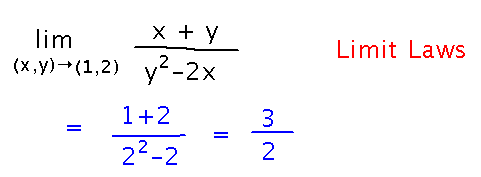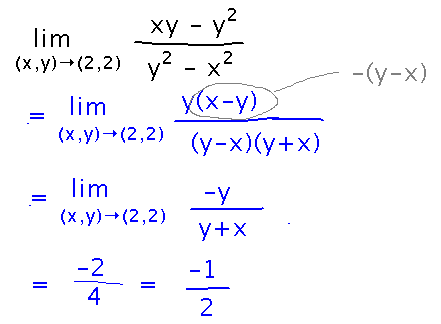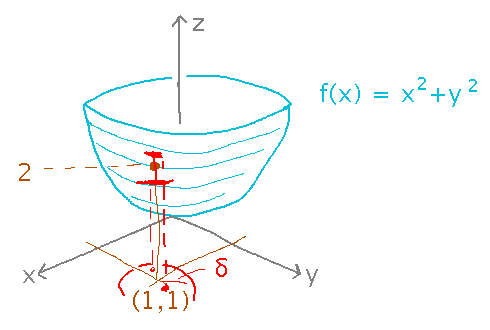Misc
Differential equations experiment is still looking for participants.
It’s a chance to...
- Get invited to a pizza party
- Get a preview of what many students see as the logical next step in calculus
- Learn something new
- Help out two fellow students.
This is the last week of the experiment. Drop in at Sturges 106
- Today (Monday) 1:00 - 3:00 or 5:00 - 7:00
- Wednesday 2:30 - 6:30
or schedule an individual time
Questions?
Definition of Limit?
The beginning of this section alludes to a formal definition of the limit of a single-variable function that captures the idea that the limit of f(x) as x approaches a is L means that getting x very close to a gets f very close to L, and in fact no matter how close to L you want to get, you can get close enough to a to do it.

Limits that Don’t Exist
How did book’s author know to use the various paths chosen in Example 13.2.2 (showing that limits don’t exist)?
Some of it is a matter of doing what’s easy and seeing if it helps, e.g., setting one variable equal to the value it’s approaching and letting only the other vary.
Some is also a matter of experience, e.g., knowing that considering approaches along different straight lines often helps show that a limit doesn’t exist.
In all cases, be careful you’re using paths that really do go through the point the limit approaches.

Limits of Multivariable Functions
Section 13.2.
Key Ideas
Limit laws for 1-variable functions extend to any number of variables. So do techniques for finding limits.
Finding Limits
Find...
lim(x,y)→(1,2) (x+y) / (y2-2x)
Just plug x = 1, y = 2 into the function, as permitted by limit laws:

lim(x,y)→(2,2) (xy-y2) / (y2-x2)
Plugging in x = 2, y = 2 yields 0/0, so use subtler techniques. Factoring works, much as it would with a single-variable limit:

lim(x,y,z)→(1,4,-2) x(y-z2) / (√y+z)
Again, you can’t just plug x = 1, y = 4, z = -2 into the function. Cleverer factoring, or multiplying by the conjugate, works to get rid of the 0/0 here.

Notice that this limit involved 3 variables. The number of variables doesn’t really affect how you find limits.
Formal Definition
Sketch a picture of what it means that lim(x,y)→(1,1) x2+y2 = 2
Much as in the single-variable case where there’s always a δ interval around a that keeps f(x) within an ε tolerance of L, there’s a δ circle around (1,1) that keeps x2+y2 within an ε tolerance of 2:

Next
Finish limits of multivariable functions, notably limits that don’t exist.
Continuity of multivariable functions.
No new reading, but review the parts of section 13.2 on limits that don’t exist and continuity.